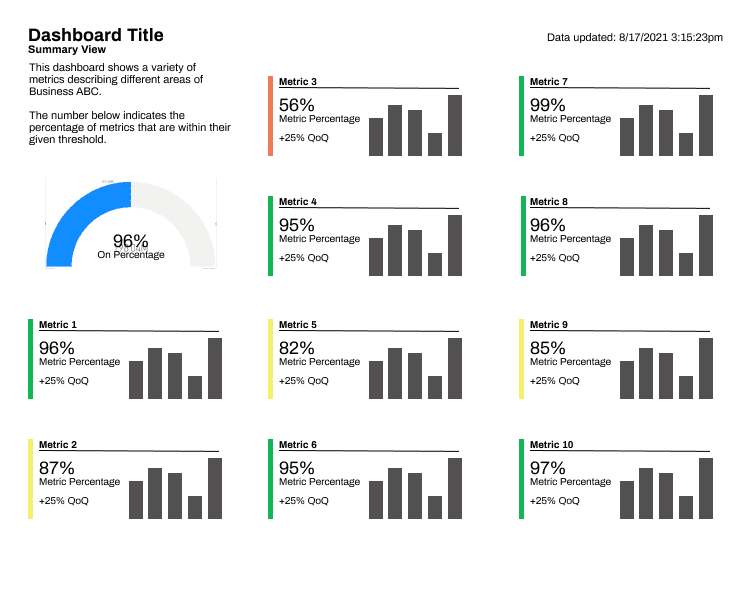If you’re a data visualization consultant, I know that you’ve faced this dilemma: you have your requirements, you understand your use cases and deliverables, but the proper data pipelines are not set up yet. But your project kicks off soon, so what do you do!? If you’ve ever found yourself in this spot, this blog post is going to give you some ideas of things that you can do to get your project going even if your data is not in it’s production end-state.
In this blog post we are going to explore how wireframing, developing dashboards with mock data, and getting involved in the data architecture roadmap can cut down your time to delivery.
Wireframing
My opinion on making wireframes have ranged from “those are utterly useless” to “I couldn’t do a project without wireframing” over the course of my consulting experience. Whether or not you are personally a fan of making wireframes, I have come to find that wireframes are very useful for a number of reasons:
- Vision – even with a lot of uncertainties during the course of a project, wireframes can help provide your project with some vision and end goals. By setting a framework for your team to work towards, wireframes can often help align your next steps.
- Design – by getting wireframes in front of stakeholders early on in the process, you are able to get ahead of a lot of the feedback on project design. This way you aren’t scrambling at the end to make a lot of really small design changes and are able to fill some of that time early on in the project when you’re waiting for data to be flushed out.
- Buy-in – clients love something they can visually see because it can help get people get excited about the project and drive buy-in either from stakeholders or management. Driving that early excitement about a project can help with adoption as well as guaranteeing budget for the full scope of the work.
Below is an example of a wireframe for a client executive dashboard. In this situation, there may be no final data source available, but you can use this wireframe for the three reasons listed above.

Now, let’s see what else we can do without a finalized data set to get your project going!
Develop with Sample Data
Even if your target data set is not finalized and in production, it is more than likely that your data will be available in some sort of snapshot form. Although we would obviously prefer a connection to a live database, this static data can still get you started moving in the right direction.
- Field Names & Data– even though this data is just a snapshot of the final version, you are more than likely going to have similar data structures and naming conventions. Using your sample data to build a static dashboard can help you start to familiarize yourself with data included in the final product
- Logic & Calculations – although you might have to redo some of the final calculations depending on how the final data is modeled, creating calculations with your sample data will help you start to formulate the criteria and logic for each of your metrics
- Rough Draft – it’s never too early to start getting content into your BI platform. It can be good to start your development early in order to plan ahead for when the final data comes through. This can cut down your time to delivery once your final dataset is received
Below, I have put a couple of metrics onto a Power BI report canvas from data extracts and set the framework for the rest of the report to come.

Let’s find out one last suggestion for what to do while waiting for Prod data.
Develop Architecture Roadmap
The last suggestion I have for people waiting on live data is to get involved in the data roadmap discussions. As the consultant who will be building solutions using this data, you can use this as an opportunity to be involved in the data modeling process which can ultimately make your life that much easier. Doing this has some key advantages:
- Model – being involved in the architecture roadmap can help the model to be built out appropriately depending on what the desires deliverables are. Whether it be specific measures, dimensions, or table structures, being involved can save you time on the back end if things aren’t built out appropriately.
- Timelines & Planning – being close to the data architecture can give you better insight into to exactly when that data pipeline might be available. This will allow you to plan out the project more efficiently, and if need be, prepare for a longer timeline/extension to the project.
- Familiarity – it’s never too early to start getting content into your BI platform. It can be good to start your development early in order to plan ahead for when the final data comes through. This can cut down your time to delivery once your final dataset is received.
Using this technique you can create indicators of your metrics that also help with the design and alignment of your dashboard.
In Conclusion
I don’t think Mike Tyson was ever an analytics consultant, but he certainly had an applicable quote:
Everyone has a plan until they punched in the face.
Mike Tyson
As any consultant can tell you, projects rarely go exactly as planned. That’s part of the fun of being a consultant! Having a perfectly curated dataset ready for development is optimal, but this is more often the exception rather than the rule. Hopefully this blog post has given you some tools on how to deal with those road bumps!
Are you an expert in Power BI, Tableau, Alteryx or Snowflake? We want you on our team! Our team is growing fast and we are looking for talented people.















